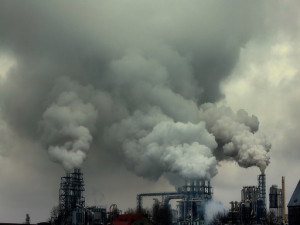
In February the whole world saw pictures of a frightening smog that descended on Beijing, with people walking around in masks trying to protect themselves from the high level of air pollution, which has exceeded safety standards many times. Breathing that air is equivalent to smoking two packs of cigarettes a day. The reason for such ecologic havoc in China’s cities is a high level of their economy’s energy intensity. Coal, the main source of energy in China, the dirtiest form, provides for 60% of the country’s energy consumption. According to the International Energy Agency’s data, China’s economy’s energy intensity is 58% higher than that of America. Any industrial revolution is accompanied by an increase in pollution. As opposed to other developing countries, China’s industrial transformation is going on faster and on a greater scale, which will deal an irreparable blow to the environment and the population’s health.
It’s been proven that air pollution increases the risk of death, in connection with heart, lung, and respiratory diseases, by 2-3% when the amount of hard particles is increased by 10 micro-grams in a cubic meter. If 300 micro-grams per cubic meter is considered the safety norm, in Beijing during the winter 2014 smog crisis, this number was 479, bearing witness to an extremely dangerous situation for the population’s health, especially for those inhabitants of the country who suffer from lung and cardiologic diseases and are in the at-risk group for early death.
Only 1% of China’s urban population (560 mil. people) lives in cities with a healthy environment. According to the official data of China’s Agency for Environmental Preservation, the state of the atmosphere in a third of 113 cities does not comply with national air pollution standards, which became the reason for a sharp increase in lung cancer patients, the death rate by which has gone up 465% in the last three decades. In Beijing the number of lung cancer patients has gone up 60% in the last 10 years; this is connected, as earlier stated, with smoking. An increase in the level of air pollution, most of all in large cities, causes early death to 750 thousand Chinese people.
In addition to industrial emissions and thermal power plants, which work on coal, we have transport emissions, which are growing at record rates. Considering the potential growth of cities, where 55% of the country’s population will be living by 2020, general societal expenses due to the worsening ecological situation are even more formidable compared with the current situation.
The thick smog that covered Beijing became a sort of catalyst for an increase in government attention to this reality; as a result a large-scale preparation is now underway for a discussion of this problem, driven by public opinion, and for taking measures towards a solution to this problem.
China continues to act to decrease its economy’s energy intensity, develop alternative sources of energy, and implement pollution-control devices. But it will still be long before the pollution situation improves. The problem is, the economy’s development is founded on growing energy usage, whereas the legitimacy of political power depends on the population’s economic well-being, which prompts many local leaders to focus as before on economic growth despite saving the environment. The current Prime Minister of the People’s Republic of China, who recently declared war on pollution, has announced that solving ecological problems is a long process.
Air pollution today represents one of the biggest threats to human health, and in densely populated countries such as India, societal expenses rise greatly because of this. Of 3 mil. deaths which occur in the world every year due to air pollution, the majority occur in India. On a list of 132 countries, India is in first place for level of air pollution, higher on the list even than China. Of the 20 dirtiest cities in the world, 13 are in India. The WHO inspected over 1600 cities in 91 countries and found that the dirtiest city is New Delhi, where the level of pollution exceeds safety norms by 1500%. One in 10 New Delhi children suffers from asthma.
But air pollution plagues not just the capital, but many provincial cities as well. The possibility of the situation getting worse is completely real, considering a sharp increase in transport, the amount of which by 2050 will reach 382 for every 1000 people. Today this figure is 8 (compare to China: 15, Brazil: 165, USA: 500). Given the weak development of public transportation and the increase in material wealth of the population, as well as the growth of the middle class, the demand for private automobiles will rise. Along with this, the reason for all the pollution is the primary use of coal as a main energy source, on which industrial enterprises and thermal electric power stations work, (the economy’s high specific energy consumption). In a word, their situation is identical to China’s.
Despite the poignancy of this problem, which grows from year to year, and despite the extremely high societal expenses that result from it, the problem of air pollution has not been within India’s government’s sights for a very long time. However, in recent years, an increase in public concern over societal losses due to air pollution has forced Indian government bodies to take some measures to solve the problem, mainly by creating stricter ecological requirements for cars and the quality of fuel used in accordance with European standards “Euro 1, 2, and 3.”However, these measures have not yet produced the expected result and the air pollution situation remains extremely strained. Meanwhile, this reduces India’s economy’s ability to compete; the economy largely depends on the labor force, the quality of which in turn depends partly on the environment.
Natalya Rogozhina, Ph.D of Political Science, Senior Research Fellow at Institute of World Economy and International Relations, RAS especially for the online magazine “New Eastern Outlook”.
